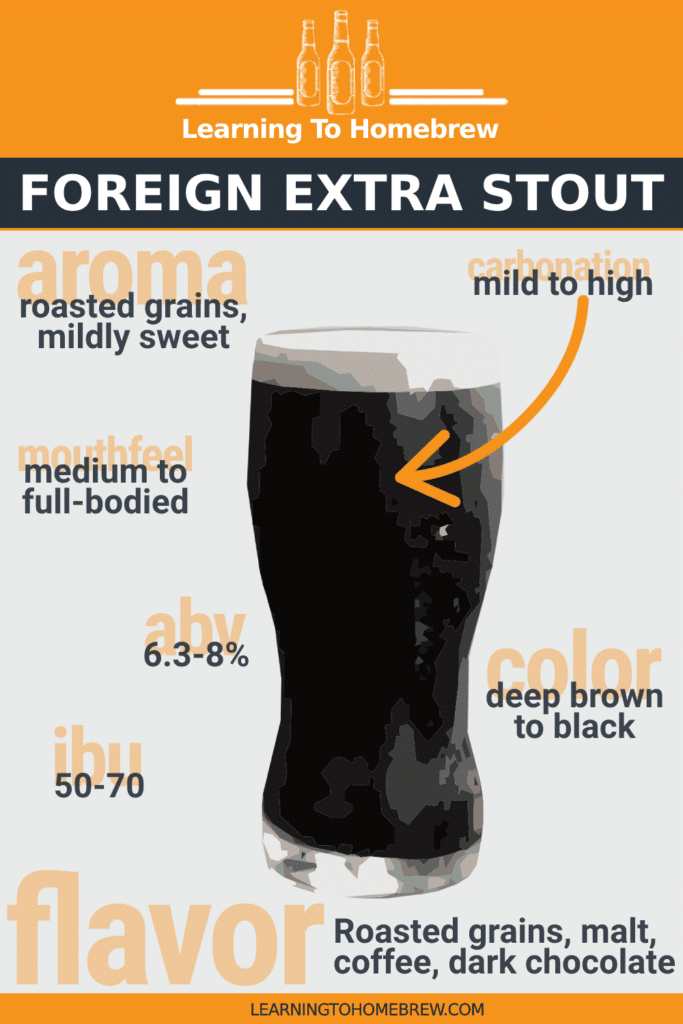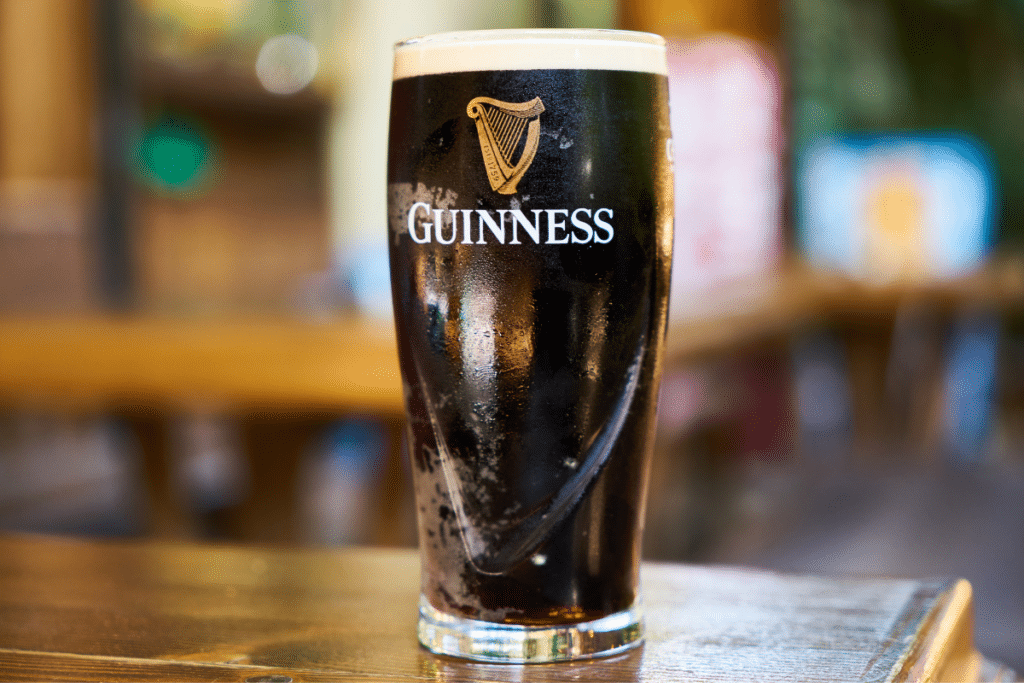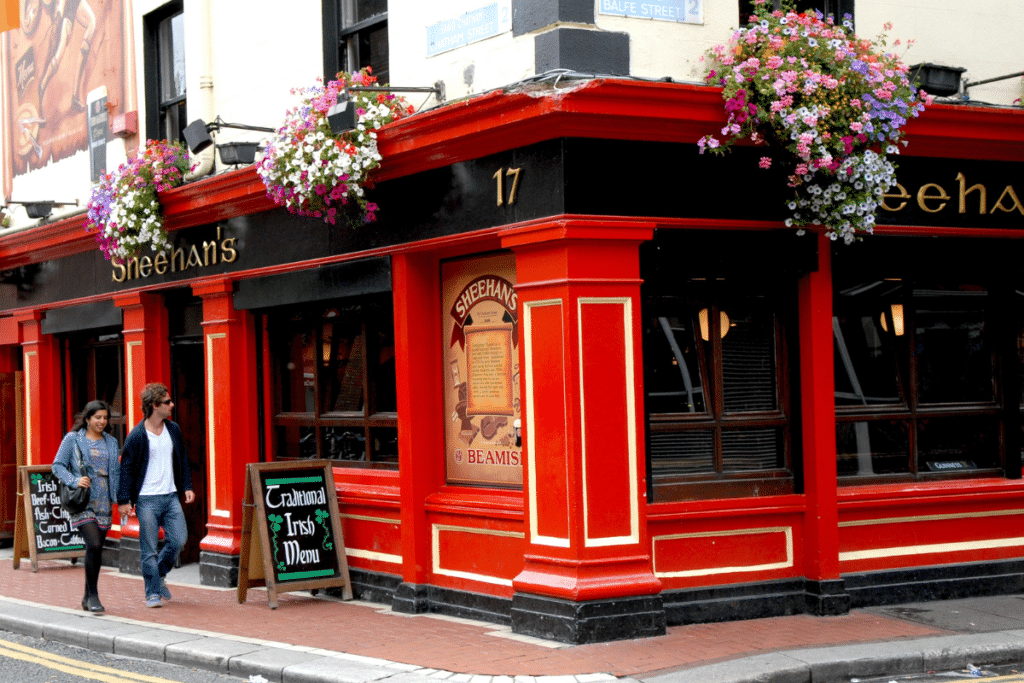Before tackling a big beer like an Imperial Stout, try your hand at a Foreign Extra Stout. This beer is a great middle step between a Dry Irish Stout and a monster Imperial Stout.
Brew a tasty Foreign Extra Stout with chloride-focused hard water, pale malt base grains, chocolate malts, roasted barley, black malts, and English hops. This stout calls for highly attenuating yeast that will not contribute much to the flavors. Ferment on the lower end for a drier beer.
Though this style acts as a middle child, its flavors and character can’t be so easily forgotten. Keep reading for the best ways to brew one of these delicious stouts plus several Foreign Extra Stout recipes.
Topics We Cover
What is a Foreign Extra Stout?
In the grand scale of stouts, a Foreign Extra Stout (aka Foreign Stout, Extra Stout) is found in the middle. It isn’t as big as an Imperial Stout though it is often stronger than a Dry Irish. While an Imperial Stout can be overwhelming, a Foreign Extra Stout maintains a pleasing balance.
The Foreign Extra Stout is a dark beer with higher than average alcohol by volume. It presents typical stout flavors such as coffee, dark chocolate, and roasted grains. This style can range from as dry as a Dry Irish Stout to a little sweeter with malt flavors.

Defining characteristics of Foreign Extra Stouts include:
- Color – Deep brown to black, 30-40 SRM
- Common flavor – Roasted grains, malt sweetness, coffee, dark chocolate
- Aroma – Roasted grains, mild sweetness, earthy
- Mouthfeel – Medium to full-bodied, mild to high carbonation
- IBUs (Bitterness) – 50-70
- ABV – 6.3-8%
Foreign Stouts primarily focus on malt flavors but the style does benefit from a quality hop profile. Hop flavors and aromas aren’t at the forefront of the style. This ingredient takes the supporting role of bittering.
History of the Foreign Extra Stout
Like the IPA, Foreign Extra Stouts were brewed to survive long shipping times from Britain to its various colonies. This puts their origins in the late 1700s and early 1800s. One of the most famous of the time (roughly 1801) was Guinness’s West India Porter.
Many Foreign Stouts were highly hopped to survive the long trip. That said, Foreign Stouts did not rely on dry hopping as IPAs did. Instead, this beer relied on a higher ABV, some hops, and occasionally secondary fermentation.
The style was enjoyed primarily in the British colonies of the 1800s though it did eventually come to America around 1817. It enjoyed popularity in the U.S. up until Prohibition. After Prohibition Extra Stouts were brought back by Guinness. There are, of course, other commercial examples.
Popular commercial Foreign Extra Stouts
For the beer enthusiasts and the beer curious here’s a quick list of Foreign Extra Stouts you should try.

- Guinness Foreign Extra Stout – This 7.5% ABV stout brings roasted flavors such as dark chocolate to the forefront. Notes of caramel and dried fruits will also grace your palate.
- Coopers Best Extra Stout – Lighter than Guinness’s offering, this Foreign Extra Stout sits at 6.3% ABV. This beer is a great example of how well fruit flavors and dark chocolate go together.
- Pelican Brewing Tsunami Export Stout – Hitting hard with cappuccino and dark chocolate flavors, the Tsunami Export Stout is a delicious brew. Its malt flavors and clean profile make for a great example of the style.
- Lion Brewery Lion Stout – This stout sits on the heavier side of Foreign Export Stouts at 8.8% ABV. Lion Stout tastes of dark roasted barley, coffee, and dark chocolate.
How to brew a Foreign Extra Stout
Once you’ve explored some great examples of Foreign Extra Stout you may be thinking of how to brew your own. In order to brew the best beer you need to know the style forward and backward. To that end, I will break down everything you need to know.
Brewing a proper Foreign Extra Stout requires water similar to the kind you’d find in Dublin – specifically, it should favor chlorides over sulfates. You’ll also need a pale malt and bittering hops, but the flavor really comes from the additions. A classic Foreign Extra Stout will use roasted barley, chocolate malts, UK black patent, and sometimes black malts.
Let’s start by going over some great choices for the recipe and ingredients. Then, we can look at the process including brew day, fermentation, and bottling.
Recipe and ingredients
While you can’t have beer without fermentation, you also can’t get anywhere without quality ingredients. There are of course no wrong ingredients, but some will go together much better than others.
As always, start with your water. Since beer is nearly 90% water, good water makes good beer. Then consider your grain bill, hops, and finally yeast. Each one can have a significant impact on your final product.
Water profile
While it’s easy to take water for granted, it makes a huge difference in the final product and often needs to be customized to be appropriate for the beer you’re brewing.
The best water profile for a Foreign Extra Stout is one that favors chlorides over sulfates. This will boost the malt flavors. You will also need to raise the alkalinity to offset the acidity that comes from the dark grains you’ll use.

If you use a water profile calculator or follow historical profiles, choose one similar to Dublin’s. This water profile serves as a decent starting point for many stouts.
If you want a more balanced beer, you can balance your chlorides and sulfates. Just keep in mind that hops are not the main focus of this beer so you shouldn’t favor the sulfates.
Base grains
Your base grains will set up the canvas for your specialty grains to add color and depth. Since this is the case, any pale malts will do the job here.
For the majority of the base grains in a Foreign Extra Stout, you can use pale malts. This will provide a clean strong foundation of malt flavors and fermentable sugars. Maris Otter Pale will serve well.
US Pale 2-row can work just as well, though British malts are a style-appropriate choice.
Specialty grains or other additions
Here is where you add the star of the beer.
A Foreign Extra Stout calls for roasted barley, chocolate malts, UK black patent, and sometimes brown malts. All of these are great options. Most brewers lean towards the British variants of each.
These specialty grains will add the flavor complexity and dark color a stout should have. Favor roasted barley for bitterness and roasted malt flavors. Chocolate malts are great for dark chocolate flavors with a hint of burnt flavors.
Choose black malts for roasted malt flavors and slightly less bitterness than roasted barley. Brown malts are great for coffee flavors and dryer stouts.
As for other additions, molasses can be a great choice as it can contribute to the dryness and add some extra flavor. Flaked oats can also be used to add body.
Hops
Hops play a role in the flavor and aroma of all beer styles, although how heavily they are featured in the final flavor varies significantly.
A Foreign Extra Stout primarily uses hops for bittering and rarely for flavor or aroma. In addition, British hop varieties are favored over American hops. As they are used for bittering, high alpha acid varieties are preferred.
That said, hop flavors and aromas are welcome in a Foreign Stout. These flavors just shouldn’t be at the forefront. You can go with just one variety of hops for this beer instead of a bunch as you would for an IPA.
If choosing just one variety, try to find one with high alpha acid concentration and desirable flavors.
Bittering
Bittering hops added early in the boil will go through a process called isomerization. This is what gives a beer its bitterness.
A Foreign Extra Stout calls for anywhere from 50 to 70 IBUs. Choose an English hop variety with a high AA concentration.
Here are some good choices for bittering hops.
| Name | Purpose | Alpha Acid % |
|---|---|---|
| Magnum | Bittering | 12-14% |
| East Kent Goldings | Aroma | 4.5-6.5% |
| Cascade | Bittering + Aroma | 4.5-7% |
| Challenger | Bittering + Aroma | 6.5-9% |
Aroma and flavor
Aroma and flavor hops added towards the end of the boil don’t add much bitterness. Instead, they add oils that provide flavor and aroma.
Foreign Extra Stouts don’t need much in the way of late hop additions.
Here are a few good choices to get you started.
| Name | Flavor/Aroma | Alpha Acid % |
|---|---|---|
| Cascade | Citrus, floral | 4.5-7% |
| Centennial | Floral, citrus, woody | 7-12% |
| Fuggles | Vegetal, woody, floral | 3.5-6% |
| East Kent Goldings | Woody, citrus, spicy, vegetal | 4.5-6.5% |
Yeast
A Foreign Extra Stout calls for a yeast strain that has medium to high attenuation, medium to high flocculation, and low ester production.
Any yeast strain you use for a stout will do well here. The best stout yeast strains will typically let the malt flavors shine without adding too much. Most leave the beer fairly dry at the end.
Dry
Below are some good dry yeast options for a Foreign Extra Stout.
| Name | Attenuation | Flocculation | Temperature Range |
|---|---|---|---|
| Safale US-05 | 78-82% | Medium | 64.4-78.8°F |
| Safale US-04 | 74-82% | High | 64.4-78.8°F |
| Nottingham | 77% | High | 50-72°F |
Liquid
Below are some good liquid yeast options for a Foreign Extra Stout.
| Name | Attenuation | Flocculation | Temperature Range |
|---|---|---|---|
| Wyeast 1084 | 71-75% | Medium | 62-72°F |
| WLP004 | 69-74% | Medium-high | 65-68°F |
| Wyeast 1099 | 68-72% | Medium-high | 64-75°F |
Brewing process
After acquiring all of your ingredients you can move on to brew day. What you do on brew day can have just as much impact on your results as your choices of ingredients. On brew day, one of the most important aspects is sanitization. Be thorough when sanitizing.
All grain, partial, and extract brewing each have important considerations for you to make. When doing all-grain or partial brewing you need to consider mashing and sparging. From there the other considerations are similar. The boil step and on is the same for all three.
Let’s break down each step with the Foreign Extra Stout in mind.
Mashing
For a Foreign Extra Stout, your mash temperature should be between 150°F and 152°F. This is on the drier side of a typical mash. If you want it to be slightly less dry you can mash it at 152°F or even slightly higher. Mash for about an hour.
You shouldn’t need to mash longer than an hour. In fact, 45 to 50 minutes should do just fine. Since this is a darker beer you may need to pay additional attention to your mash pH. However, if your water profile is just right, you’ll be fine.
Boil
The boil for a Foreign Extra Stout should be an hour long. Most of your hop additions will be right at the beginning of the boil. Your recipe may call for a late boil hop addition, but likely only one.
Use your high alpha acid concentration hops at the beginning of the boil for maximum effect. Most early additions will be between an hour left and 45 minutes left. Any late boil additions will be from 15 minutes left to 5 minutes left.
Whirlpool or flameout
There are other times to add hops; although they are not common for this style, you can use them if you so choose.
Adding hops during flameout can be a great way to get the flavors and almost no bitterness. This is done directly after the boil and before you pitch yeast. As you transfer to your fermentor, create a whirlpool as you drain the boiling vessel.
This is only possible when you have a vessel that can drain from the bottom. Whirlpooling can also be a great way to collect the trub in the middle and reduce the amount that gets in your fermentor.
Fermentation
As always, fermentation is crucial but mostly hands-off.
Ensure that your fermenting Foreign Extra Stout stays at a consistent temperature. Start with the temperature on the lower end of your yeast’s viable range. If you want a little bit of ester production, raise the temp slightly after a few days in primary.
Keeping the fermentation on the lower end will help keep your brew clean from any fermentation byproducts.
Temperatures
While the temperatures are yeast dependent, there is a rough range you should keep your Foreign Extra Stout near.
Try to keep your fermentor around 60-64°F for the entirety of the process. However, you can raise the temp by a few degrees on the second half for a little extra flavor.
If you miss your temp goals by a few degrees or can’t keep it consistent, it won’t be the end of the world. This level of micromanaging is great for elevating your final product but isn’t essential.
Bottling or kegging
The debate between bottling and kegging will go on for as long as brewers have a choice. It is truly up to personal preference and setup.
There is little preference between bottling and kegging for Foreign Extra Stouts. Kegging will allow you to bulk condition while bottles can make it easier to save portions for aging.
Choose the method that is easiest for you.
Foreign Extra Stout recipes
If you aren’t one to create your own recipes here are a few that you can follow for great results.
These recipes are from various brewers and are credited below:
- Sour Baby Jesus (All Grain)
- Lucifer’s Dessert (All Grain)
- Dark Passenger Stout (Extract)
Sour Baby Jesus (All Grain)
This recipe comes from user phlyingpenguin on Brewer’s Friend.
Ingredients
- Maris Otter Pale – 11.5 lbs
- US Crystal 40° L – 1 lb
- US Crystal 80° L – 1 lb
- US Aromatic Malt – 1.5 lbs
- US Chocolate Malt – 0.75 lbs
- US Roasted Barley – 0.5 lbs
- US Black Malt – 0.5 lbs
- US Special Roast – 0.5 lbs
- Fuggles – 1.5 oz
- East Kent Goldings – 0.75 oz
- PB2 – 6.5 oz
- Cocoa – 8 oz
- Wyeast 1272
Method
- Heat 6.5 gallons to 152° F
- Add grain bill and mash for 1 hour.
- Mashout.
- Collect 8 gallons of wort.
- Boil for 60 minutes. Add 1 oz of Fuggles and the East Kent Goldings at the beginning.
- At 10 minutes left add the rest of the Fuggles.
- At 5 minutes left add the PB2 and the Cocoa.
- Flameout and transfer to the fermentor.
- Cool and pitch yeast.
- Maintain 65° F during fermentation.
- Rack to keg or bottles. Enjoy!
Lucifer’s Dessert (All Grain)
This recipe comes from user Brewer #49703 on Brewer’s Friend.
Ingredients
- US Pale 2-row – 13 lbs
- US Chocolate Malt – 0.25 lbs
- US Midnight Wheat Malt – 0.5 lbs
- US Crystal 40° L – 0.5 lbs
- UK Roasted Barley – 0.25 lbs
- Newport – 1 oz
- GR Polaris – 1 oz
- Vanilla Beans – 3
- Toasted Oak Chips – 1 oz
- Wyeast 1056
Method
- Make a vanilla bean tincture using a neutral spirit.
- Heat 5.5 gallons to 150° F
- Add grain bill and mash for 1 hour.
- Mashout.
- Collect 6.5 gallons of wort.
- Boil for 60 minutes. Add the Newport at the beginning.
- At 7 minutes left add the GR Polaris.
- Flameout and transfer to the fermentor.
- Cool and pitch yeast.
- Maintain 64° F during fermentation.
- Transfer to secondary. Add the vanilla bean tincture and the oak chips.
- Secondary ferment for 2 weeks.
- Rack to keg or bottles. Enjoy!
Dark Passenger Stout (Extract)
This recipe comes from user Potable Pastime on Brewer’s Friend.
Ingredients
- Dark DME – 1.5 lbs
- US Chocolate – 0.11 lbs
- Belgian Roasted Barley – 0.08 lbs
- UK Black Patent – 0.08 lbs
- US Carapils – 0.11 lbs
- Goldings – 1 oz
- Safale S-04
Method
- Heat 7.5 gallons of water for your boil.
- Add the steeping grains when the water is around 140° F.
- Remove the grains when the water is around 170° F.
- When a boil is reached, add the malt extract.
- Boil for 60 minutes. Add the hops right away.
- Flameout and transfer to the fermentor.
- Cool and pitch yeast.
- Maintain 62° F during fermentation.
- After a week in fermentation, rack to keg and force carbonate or bottle condition.
Did you know that we have a full library of homebrew beer recipes for every style?





